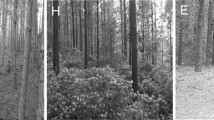Summary
We examined the movements of Chrysophtharta hectica, a eucalypt-feeding chrysomelid beetle in New South Wales, Australia, in relation to the beetle's sex, age and life-history, and to attributes of its Eucalyptus host plants. Beetle movements within the site were not influenced by beetle age or sex, but may be related to generation. Beetle distributions on the two host plant species, Eucalyptus stellulata and E. pauciflora, were generally clumped. Some of this clumping resulted from preference for E. stellulata over E. pauciflora. Clumping of beetles also occurred within host plant species; some plant individuals were consistently heavily used by beetles over the course of three years. We examined nutritional, spatial and biomass attributes of plants and found plant height and foliage production to be the best predictors of beetle numbers.
Similar content being viewed by others
References
Bergelson J, Kareiva P (1987) Barriers to movement and the response of herbivores to alternate cropping patterns. Oecologia (Berlin) 71:457–460
Carne PB (1966) Ecological characteristics of the eucalypt-defoliating chrysomelid Paropsis atomaria. Aust J Zool 14:647–672
Carne PB, Taylor KL (1978) Insect pests. In: Hills WE, Brown AG (eds) Eucalypts for wood production. Griffin Press, CSIRO Adelaide
Cromartie J (1975) The effect of stand size and vegetational background on the colonization of cruciferous plants by herbivorous insects. J Appl Ecol 12:517–533
Cumpston MD (1939) Observations on the bionomics and morphology of seven species of the tribe Paropsini (Chrysomelidae). Proc Linn Soc NSW 64:353–366
de Little DW, Madden JL (1975) Host preference in the Tasmanian eucalypt-defoliating Paropsini (Coleoptera: Chrysomelidae) with particular reference to Chrysophtharta bimaculata (Olivier) and C. agricola (Chapuis). J Ans Ent Soc 14:387–394
Dixon WJ (ed) (1983) BMDP Biomedical Computer Programs. University of California Press, Berkeley
Dobzhansky Th, Wright S (1943) Genetics of natural populations. X. Dispersion rates in Drosophila pseudoobscura. Genetics 93:262–284
Fox LR, Macauley BJ (1977) Insect grazing on Eucalyptus in response to variation in leaf tannins and nitrogen. Oecologia (Berlin) 29:145–162
Fox LR, Morrow PA (1981) Specialization: species property or local phenomenon? Science 211:887–892
Harman DM (1975) Movement of individually marked white pine weevils, Pissodes strobi. Environ Entomol 4:120–124
Jansson RK, Smilowitz Z (1986) Influence of potato persistence, foliar biomass and foliar nitrogen on abundance of Leptinotarsa decemlineata (Coleoptera: Chrysomelidae). Environ Entomol 15:726–732
Kareiva P (1982) Experimental and mathematical analyses of herbivore movement: quantifying the influence of plant spacing and quality on foraging discrimination. Ecol Monogr 52:261–282
Lawrence WS (1982) Sexual dimorphism in between and within patch movements of a monophagous insect: Tetraopes (Coleoptera: Cerambycidae). Oecologia (Berlin) 53:245–250
Mason ML, Lawson FA (1980) Dispersal of the pre-overwintering adult stage of the American aspen beetle (Coleoptera: Chrysomelidae); Gonioctena americana (Schaeffer) using Hg-203. J Kans Entomol Soc 53:595–596
McCauley DE (1983) Gene flow distances in natural populations of Tetraopes tetraophthalmus. Evolution 37:1239–1246
Morrow PA, Fox LR (1981) Effects of variation in Eucalyptus essential oil yield on insect growth and grazing damage. Oecologia (Berlin) 45:209–219
Parker M (1984) Local food depletion and the foraging behavior of a specialist grasshopper, Hesperotettix viridis. Ecology 65:824–835
Pryor LD (1956) Variation in snow gum (Eucalyptus pauciflora Sieb). Proc Linn Soc NSW 81:299–305
Pryor LD, Johnson LAS (1971) A classification of the eucalypts. Australian National University Press, Canberra, 102 pp
Root RB (1973) Organization of a plant-arthropod association in simple and diverse habitats: the fauna of collards (Brassica oleracea). Ecol Monogr 43:94–125
Rosenthal GA, Janzen DH (1979) Herbivores: their interaction with secondary plant metabolites. Academic Press, New York, 718 pp
Scriber JM, Slansky F (1981) The nutritional ecology of immature insects. Annu Rev Entomol 26:183–211
Stanton ML (1982) Searching in a patchy environment: foodplant selection by Colias p. eriphyle butterflies. Ecology 63:839–853
Turchin P (1987) The role of aggregation in the response of Mexican bean beetles to host-plant density. Oecologia (Berl) 71:577–582
Watt WB, Chew FS, Snyder LRG, Watt AG, Rothschild DE (1977) Population structure of pierid butterflies. I. Numbers and movements of some montane Colias species. Oecologia (Berlin) 27:1–22
Weisberg S (1984) Applied linear regression. Wiley, New York, 324 pp
Author information
Authors and Affiliations
Rights and permissions
About this article
Cite this article
Strauss, S.Y., Morrow, P.A. Movement patterns of an Australian chrysomelid beetle in a stand of two Eucalyptus host species. Oecologia 77, 231–237 (1988). https://doi.org/10.1007/BF00379191
Received:
Issue Date:
DOI: https://doi.org/10.1007/BF00379191




